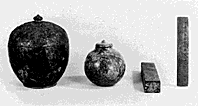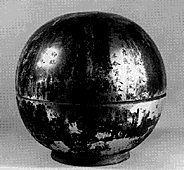
|
7From the latter part of the 7th century through the end of the 8th century, it was a common practice, in imitation of Chinese custom, to place epitaphs (boshi) inside of tombs. These epitaphs consisted largely of chronological r~sum~s of the lives of the de-creased, recorded on silver or bronze strips of metal, rectangular tiles. cinerary urns, and the like.
TOMB INSCRIPTIONS(Ono-no-Emishi's)
The epitaph shown on the left of the page belongs to the tomb of Ono-no-Emishi. son of Ono-no-Imoko, poet and emissary to Sul China. From this inscription we learn that Emishi held the post of Dajokan (prime minister) in the service of Emperor Tenmu, conjointly with the post of chief administrator (chokan) of the Ministry of Justice (kyobusho) . He died in 677 (the 5th year of Tenmu's reign) and was posthumously awarded the rank of daikin-jo. The epitaph was unearthed from , Ono-no-Emishi's burial site (an inhumation grave) on the hill be-hind the Sudo Jinja in Kyoto.
|
|

Ono-no-Emishi's
Tomb
Inscriotions
|
|

Fumi-no-Nemaro

|
|
TOMB INSCRIPTIONS
(Fumi-no-Nemaro)
The illustrations at the bottom of the page show the cinerary urn and epitaph belonging to the tomb of Fumi-no-Nemaro, a general of immigrant descent who was active in support of Tenmu during the Jinshin Disturbance (672). He died in the year 700. The cinerary urn is made of green glass and was placed within a gilt bronze vessel. The inscription was placed inside a box,also of gilt bronze.
|
|
|
|
|
|Asuka Period
|THE ASUKA PALACES
|ASUKA STONES
|ASUKA KOFUN|
|TAKAMATSUZUKA KOFUN
|THE ASUKA TEMPLES
|ASUKA AND THE MAN'YOSHU|
Copyright (c) 1995 ASUKA HISTORICAL MUSEUM All Rights Reserved.
Any request to kakiya@lint.ne.jp
Authoring: Yasuhito Kakiya
|